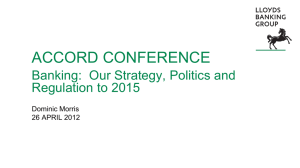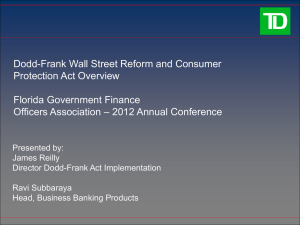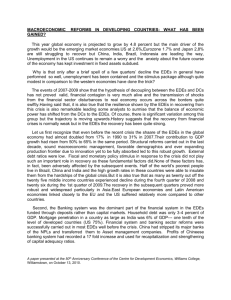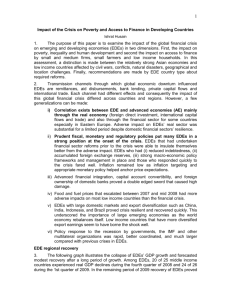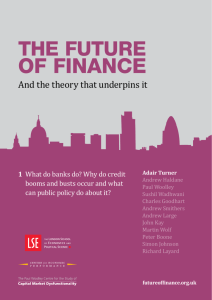Global Financial Crisis
advertisement
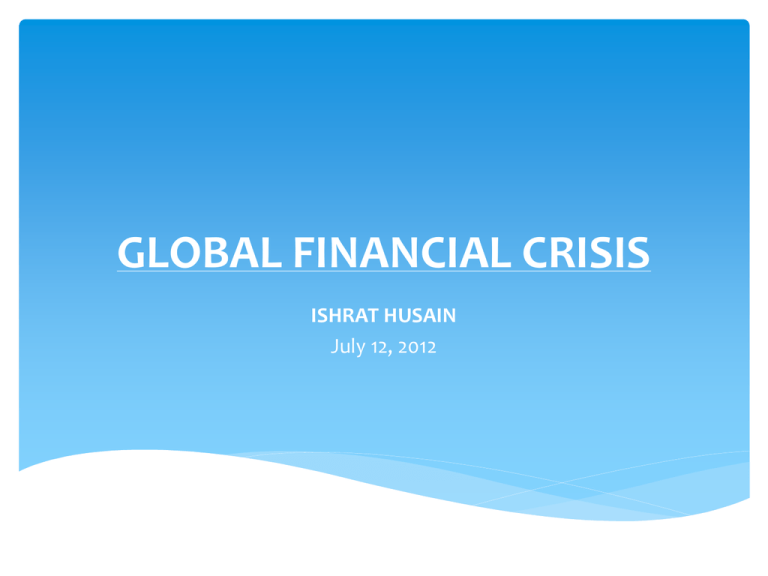
GLOBAL FINANCIAL CRISIS ISHRAT HUSAIN July 12, 2012 AGENDA CONTEXT AND BACKGROUND BRIEF CHRONOLOGY OF KEY EVENTS CONTRIBUTORY FACTORS WHAT WENT WRONG RESPONSE TO THE CRISIS IMPACT OF CRISIS IN PAKISTAN SALIENT FEATURES AND LESSONS LEARNT LESSONS ON CORPORATE GOVERNANCE OECD FINDINGS LESSONS FOR SHAREHOLDERS KEY QUESTIONS TO ASK – BOARD ASS... 2 Context and Background World economy has recorded fastest growth in the last 50 years ushering in an unprecedented era of prosperity for the majority of the population. Even in this decade of slow growth the global economy will grow to 10 to 20 percent faster than it did a decade ago, 60 percent faster than it did two decades ago, and five times as fast as it did three decades ago. 3 Context and Background (Continued) Developing and emerging economies which were impoverished and faced with poverty, hunger, illiteracy have been able to make a remarkable turn around and increased their share of world GDP from almost negligible proportion to almost 50 percent. In 1980, the number of countries that were growing at 4 percent a year was around 60. by 2007, it had doubled to 120. even now, after the financial crisis and recession the number is more than 80. Then annual average growth rate in the last decade was an impressive 6.4 percent. 4 Context and Background (Continued) Poverty has been reduced more in the past 50 years than in the previous 500 years. About one billion people have been lifted out of poverty since 1980. The proportion of people living below the poverty line has dramatically fallen from 52 percent to about 20 percent in this period. Between 2005 and 2010 both the poverty rate and the number of people living in extreme poverty have fallen in all the six developing countries, the first time that has happened. 5 Context and Background (Continued) The World Bank projections show that the global target of the Millennium Development Goals (MDG) of halving World poverty has been achieved five years early. Rising agriculture production has kept ahead of population growth. World Food Production Index rose by 75% in the last 20 years while population grew by 50 percent in the same period. 6 Context and Background (Continued) Mobility of people, capital, ideas, goods and services across country border has never been as high as in the last two decades. Technological revolution inform of Internet, mobile phones, cable and satellite TV, networking, have made communication and connectivity easy and physical distances shrink. Cell phones today have more computing power the Apollo Space Capsule. 7 Context and Background (Continued) World Trade growth has consistently outpaced world output growth; Capital flows in form of portfolio investment, loans equity investment, remittances, official aid have risen sharply. This increased mobility of factors and integration of markets would therefore have consequences – both positive as well as negative. 8 Context and Background (Continued) Financial markets have peculiar characteristics and the spillovers and contagion effect are more pronounced and highly destabilizing if triggered by a negative shock. The correlation between distant markets and different types of assets has increased. 9 Context and Background (Continued) Financial innovation and financial engineering based on complex models gave rise to new products that has transformed the basic landscape of Derivatives, credit default swaps, collateralized debt obligations, securitization were developed as instruments to manage and mitigate risks. 10 Trigger Point Sub-Prime lending Defining it A loan made to someone with weak credit Little or no down payment Teaser rates and adjustable rates “Liars’ loans” 11 Brief chronology of key events March 2008 Bear Stearns is sold to J.P. Morgan for $ 240 million with Fed backing. A year ago it was valued at $ 35 billion. 12 Brief chronology of key events (Continued) October 2008 UK government announces a $ 88 billion rescue plan for the financial system. Takes major stake in UK banks. US government approves a $ 700 billion plan. European and Asian governments follow suit. Iceland takes over a third bank and obtains IMF assistance to cope with the financial crisis. Contagion, spillovers, linkages and herd instincts proved to be fairly strong and the EDEs also suffered output and export losses. However, they recovered much quickly than the AEs. 13 Contributory factors (Continued) Other factors were: Excess global liquidity and globalization of investment flows Federal reserve policy response of monetary easing Asset inflation (housing and commodities bubbles) Poor and incomplete supervision and oversight of shadow banking system Pressure to grow revenues by taking more risk Excessive leverage Pervasive reliance on mathematical models External credit ratings substitute for banks own due diligence Deficiencies in the “Originate to distribute” model vs. previous “Originate to Hold” model Over-extended borrowers Vulnerable to unscrupulous lending practices 14 What went wrong? Banking System Poor governance practices Short term focus of remuneration packages Use of ROE based indicators led to excessive leverage Risk and business units operating in “silos”; Risk given back seat External ratings replaced internal risk assessment Over dependence on short-term funding sources - Widening maturity gaps Securitization and innovation; “Originate to Distribute” slice and dice model had flaws Unethical mortgage brokers and lending practices 15 What went wrong? Shadow Banking In the absence of regulatory oversight and supervision excessive risk taking on leveraged funds. Rapid sale of assets in a crisis caused liquidity spirals Moral hazard created by “asymmetric fee structure” of hedge funds Contributing to greater systemic risk 16 What went wrong? Credit rating agencies Significant underestimation of the risks of structured products Conflict of interest Relationship conflicts: Long, established relationships with CDO and MBS issuers Issuer-paid model: “… paid by the very people whose products they rate” Advisory business: CRAs advised banks on structuring MBSs leading to good rating Exacerbating the asset price spirals Mass downgrades during late 2007 triggered the limits of many institutional investors, leading to forced selling Pro-cyclical nature of credit ratings 17 What went wrong? Flawed Theoretical Assumption Efficient Market Hypothesis (EMH) has been the predominant theory governing financial markets. The assumption that market prices are based on rationality has proved wrong in practice. Individual rationality does not ensure collective rationality. Individual does not always behave rationally but in network economy his/ her behavior depends on what others are doing. Herd instinct is a common observable trait. Securitization was believed to improve financial stability. In actual fact, trading in these marketable instruments made them vulnerable to market sentiment. 18 What went wrong? Flawed Theoretical Assumption (Continued) Mathematical models and algorithms would allow financial innovation, ease in manufacturing and trading in complex derivatives such as credit default swaps (CDSs) and collateralized Debt Obligations (CDOs). The models made the assessment of credit quality of underlying loans quite difficult and complicated. There were serious omissions in the specifications of models such as complete exclusion of high risk events, systemic risks and nonlinearity. Information asymmetry and Moral hazard have been studied extensively in economics literature but their application in designing new financial products was far from satisfactory. 19 What went wrong? Regulators Missing macro-prudential supervision Pro-cyclical capital requirements Built-in reliance on rating agency opinions Little attention to liquidity risk and the risk of trading book of banks During the crisis, many weak banks were allowed to merge with other banks. This in turn created many “too big to fail” institutions Creation of deposit insurances has exacerbated the moral hazard problem Weak regulatory framework for market infrastructure – Payment and settlement systems 20 Response to the crisis A summary of responses Business activities and ownership Compensation Regulators‘ response Response by the industry » Supervisors are challenging: Underwriting standards Rating process Securitization markets » Central bank funding replaces interbank market » Better operational infrastructure » New deposit protection schemes » Significant state involvement in the banking sector » Rethink business model » Aggressively reduce balance sheet » Increased cost of doing business » Shifting focus to domestic markets » Reduced risk appetite » Shift towards earning greater fee based income » Greater oversight Avoid undue risk-taking » Guidelines on compensation practices » Overhaul remuneration approach » Greater symmetry between risk horizons and compensation » Claw-backs 21 Response to the crisis A summary of responses Risk management & control Regulators‘ response Response by the industry » Supervisors are demanding: Greater Board/management oversight Better understanding of risks Stronger risk aggregation » Strengthening guidance relating to risk management » Supervisors are challenging: Historical risk measures in an ‘originate-to-distribute’ model VaR models and stress testing scenarios Assumptions of new product risks » Supervisors are hiring more specialists in risk management and control » Rethink reliance on sophisticated modeling » Capture ‘tail-risks’ » Intensify direct dialogue of Board members with supervisors » Improve risk reporting: Content Frequency Addressees 22 Response to the crisis A summary of responses Regulators‘ response Capital and leverage Liquidity Response by the industry Additional capital buffers Backstop leverage ratios Changing treatment of securitization and trading book Greater scrutiny of capital/balance sheet planning » Rapid deleveraging and divestitures » Greater capital buffers » Reconsider capital allocation models » Long-term funding » Capital with government support Improved management, oversight and governance of liquidity risk Contingency planning Additional reporting Link capital with liquidity Better liquidity risk management » Enhance models, stress testing and contingency planning » Identify alternate funding mechanisms » Develop stringent internal controls on liquidity risk 23 Response to the crisis A summary of responses Regulators‘ response Response by the industry Strengthened risk disclosures Rigorous valuation processes Robust valuation disclosures » Reassessment of the contribution of MTM to pro-cyclicality » Use of measures like Mark-tofunding » Benchmark risk disclosures and valuation practices against other financial institutions Valuation, Accounting and Disclosures 24 Impact of the crisis on Pakistan Financial sector reforms in the pre-crisis period had strengthened the Financial soundness Indicators of the banking system. Private sector ownership and management brought about efficiency but a strong regulatory regime did reform its watchdog function in continuing exercise risk taking. Plain Vanilla Derivatives were introduced gradually on a case-bycase basis. Cautious liberalization particularly on capital account convertibility insulated the banking system from contagion shock. Non-banking system was a minor player in the game and could not cause any ripples. 25 Impact of the crisis on Pakistan (Continued) Banking sector had little lending exposure in troubled countries Trading book almost non-existent Exposure to securitized products was limited However, an indirect (and in some cases the direct) impact is felt There is a lag effect Liquidity dried up (or cost of funding increased) Concentration in portfolios Name lending portfolio quality is uncertain FDI flows are not certain - Linked to economic growth 26 Salient Features and Lessons Learnt The question therefore arises as to what were the salient features that distinguished the US and European systems from those in Canada, Australia and New Zealand and the EDEs and what are the lessons learnt? First, Bank lending forms the bulk of financial sector lending in EDEs and Capital markets are not so well developed unlike the US and Europe. The contagion risk and transmission effect of an interconnected world capital markets in the EDEs remained muted. 27 Salient Features and Lessons Learnt (Continued) Second, Asian countries had learnt the hard way from the crisis they face in 1997-98. Prudent macroeconomic management, credibility of policy makers, open trading and investment regimes, accumulation of sufficient foreign exchange reserves combined together to maintain an enabling environment for growth and stability. 28 Salient Features and Lessons Learnt (Continued) Third, the banks in EDEs relied upon low cost and stable deposits for financing their assets rather than wholesale funding that was volatile and expensive. This permitted maturity transformation, ample liquidity to the system and preserved confidence among investors. In the US and Europe, abrupt withdrawal of wholesale funds led to a vicious cycle of distressed sales of assets, falling asset values, shortages in capital adequacy and difficulties in raising fresh capital from the private sources. 29 Salient Features and Lessons Learnt (Continued) Fourth, the Central banks in EDEs had developed the capacity to draw the rules of the game and enforce them in a way that was orderly and least disruptive. The quality of banks’ portfolio had improved as a result of the Central banks vigilance and continuous watchdog monitoring. Mark-to-Market accounting, loan-loss provisioning and capital infusion helped the strengthening of the banks. 30 Salient Features and Lessons Learnt (Continued) Fifth, the bank lending in EFEs avoided exotic products such as derivatives, loans to hedge funds, private equity, credit default swaps. Capital infusion from time to time helped strengthen the balance sheets. Sixth, partial capital controls and lack of full capital convertibility in China, India, Pakistan, did not allow large exposure to foreign currency denominated assets. The market share of the large financial conglomerates was kept limited by design and therefore direct exposure of the significantly important financial institutions was quite low. 31 Salient Features and Lessons Learnt (Continued) Seventh, as the markets in EDEs are generally considered imperfect or incomplete and market failures loom large on the horizon the intellectual foundation of contemporary financial theory – efficient market hypothesis – did not assume a pivotal role as in the developed markets and therefore, did not lead to the widespread belief and practice in Market is self correcting and therefore, a hands-off approach by the regulators. 32 Lessons on Corporate governance OECD Findings 1. Independence of Boards is a necessary, but not a sufficient condition for good governance 2. Shareholders nominate Board members; involved in their appointment and evaluation 3. Separation of the Chairman/CEO position 4. Board member liability; no consensus on existing practices 5. Identifying skills-sets of Directors best suited for the Bank’s Board 6. ‘Fit and proper’ should include general governance and risk management skills 7. Independence can be affected by the time board members have served under the same CEO or Chair 8. Adopt voluntary practices to improve Corporate Governance 33 Lessons for Shareholders Key questions to ask – Board assessment Risk oversight Board composition Director qualifications » Is risk management a key component in the company’s overall strategy? » Has the Board articulated its risk strategy? » What mechanisms does the Board have in place to evaluate risk? » What is the role of the CRO and the reporting structure? » What changes has the Board made to its structure as a response to the crisis? » How effective are the committees or the Board in overseeing risk? » Has the Board appointed sufficient independent Directors? » Are long-tenured directors serving on the Board? » Is the Board equipped with adequate risk expertise? » Is the Board considering director qualifications in the nominating process ? » What process does the Board have to train NEDs on risk management? » Do the Directors adhere to a minimum time commitment? Disclosure practices Compensation practices Conflicts of interest » What steps has the Board taken to improve transparency of the bank’s risk-taking initiatives? » Are risky instruments fully disclosed to shareholders? » Does the Bank have an updated Disclosure policy? » Does the Bank disclose Board meeting minutes, attendance etc.? » What percentage of pay is skewed toward short-term individual performance? » Do pay practices include “clawback” provisions? » Does the Bank have an updated Remuneration policy? » Does the Board have a Conflict of Interest policy which mitigates potential conflicts that could distort the Board and management’s understanding of potential risks? » Are all related party transactions, conflicts of interest disclosed?
